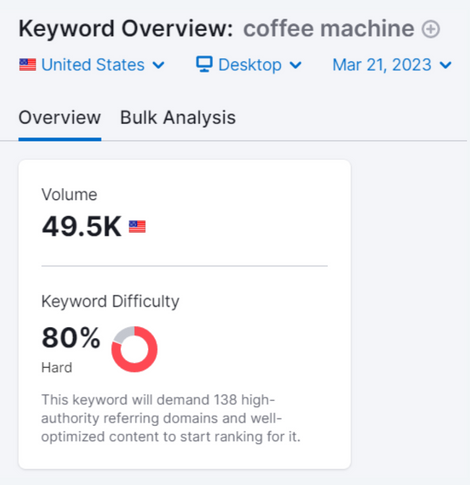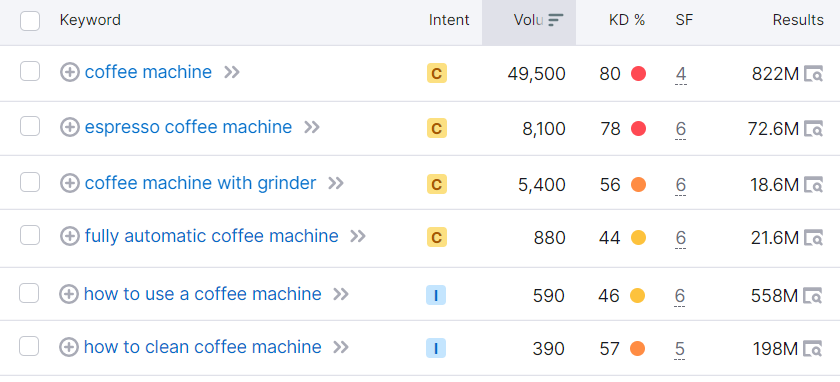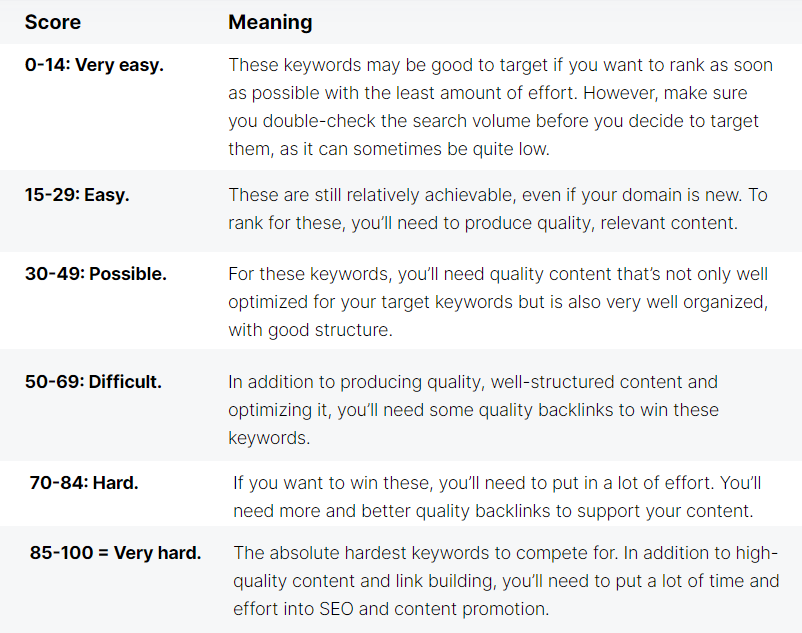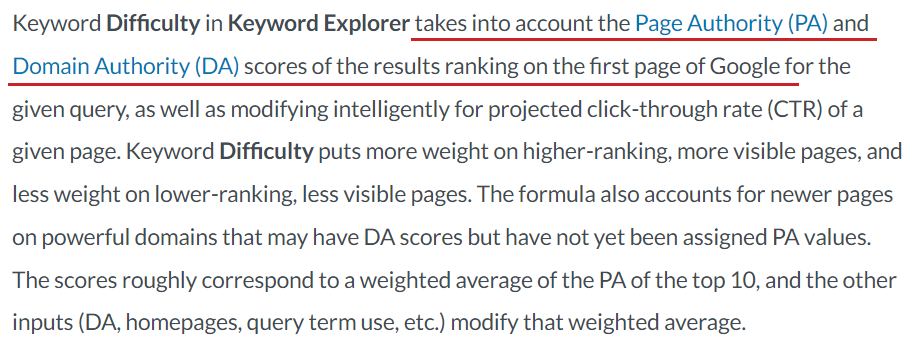Keyword Difficulty Explained
When you start doing your keyword research the two most important metrics you need to look at are: Monthly Search Volume and Keyword Difficulty.

No matter what SEO Keyword Research Tool you’re using (Ahrefs, Semrush, etc.), they’ll always display the Search Volume and Difficulty score for a keyword.
For example, the term “coffee machine” has 49,500 monthly searches in the US and Keyword Difficulty of 80%, according to Semrush.
Looking at both metrics will help you determine for which keywords you have the highest chance of ranking in the top 10 search results of Google.
While Search Volume is pretty self explanatory (it shows the number of times the query is searched as a monthly average), the Difficulty Score is more complex and needs to be explained in more detail.
What is Keyword Difficulty?
The Keyword Difficulty (or Competition) will indicate if it’s easy, medium, hard, or super hard to rank for this keyword in Google. Knowing this score will help you when planning out what content you want to have on your website.
Overall, the higher the score the harder it is to rank for this keyword in Google’s top 10 search results.
You don’t want to target keywords that are too hard, otherwise you may end up on page two or more of Google’s search results, bringing you very little or no traffic at all.
To avoid this from happening, the first thing you need to do is determine your domain’s Authority Rating.
If your website is new (with a low Authority Rating), you want to aim at very low competition search terms. On the other hand if you have an established website, then you can target keywords that have a medium or high keyword difficulty score.
Search volume vs. keyword difficulty
As a rule of thumb, keywords with high monthly Search Volume also have a high Difficulty Score.
You’ll notice that the “seed keyword” or “head term” in an industry generally has a very high Search Volume and also a high Keyword Difficulty score. This means that they’re searched for a lot, but their competition is also very high.
On the other hand you also have “long tail keywords”, which consist of 3-5 words and are more specific. Their Search Volume will be lower, however generally their Difficulty is also lower, which makes them easier to rank for.
For example, “coffee machine” is a head term and has 49,500 Volume and 80% Difficulty Score in the US according to Semrush. This means that you need to have a very well optimized content and around 138 high authority referring domains pointing to your page in order to rank for it.

As the keywords become more specific or “long-tail”, their Search Volume and Difficulty is also lower.
The term “coffee machine with grinder” is searched 5,400 times a month and has a difficulty of 56%. You will need to create an optimized content and have around 31 referring domains in order to rank.
When evaluating which keywords to target, make sure you also check the search intent of the keyword, if it’s commercial, informational, navigational or transactional. Also bear in mind the number and type of SERP Features that show on Google.
From the keyword list above, we can see that the query “how to use a coffee machine” is a good topic for a blog post. Chances are that some of the people who want to know how to use a coffee machine will also be interested in buying one.
Ultimately your goal is to pick keywords for your site, for which you have a good chance to rank for in the top 10 search results of Google, and will also bring a decent amount of traffic.
Picking the right keywords will help you create content, which will bring more relevant traffic and visitors to your site, and ultimately increase your sales.
Check out our blog post on How to find long tail keywords for your website using Quora and Reddit?
How is keyword difficulty calculated?
Generally, SEO tools display keyword difficulty as a number between 0 to 100, with 0 being the easiest and 100 being the hardest.
These tools look at the SERP results for your search query. They then take into consideration different factors, however the main ones are: how many backlinks the SERP results have and what’s the domain/URL authority of each SERP.
However, if you check the Difficulty score for the same keyword using one of the leading SEO tools, you’ll notice that the number they provide can differ substantially.

Now, let’s see how some of the more popular SEO tools calculate this score. This way you’ll know how to interpret the data and make more informed decisions.
How does Ahrefs calculate keyword difficulty?
Ahrefs calculates the Keyword Difficulty Score by looking at the number of backlinks the top 10 ranking pages have for your keyword. The more backlinks they have, the higher the KD score (on a scale of 0-100), and ultimately the harder it is to rank for it.
Ahrefs’ reasoning behind this methodology, is that backlinks or referring domains are one of the top ranking factors Google uses when deciding which sites to show in its search results.
Here is a clear explanation from Ahrefs:

Ahrefs will show a KD score from 0-100 (0 being the easiest and 100 being the hardest). Plus they’ll also tell you how many backlinks you need in order to rank in the top 10 results.
Below is a breakdown of Ahrefs’s Keyword Difficulty Score:
- 0-10 Easy: You’ll need less than 10 domains
- 11-30 Medium: You’ll need 11-36 domains
- 31-70 Hard: You’ll need 37-200 domains
- 71-100 Super Hard: You’ll need 200+ domains

Below is an even more detailed breakdown of KD vs. referring domains needed:

How does Semrush calculate keyword difficulty?
Semrush calculates the difficulty of a keyword as a percentage, ranging from 0 to 100. Zero score means that it’s very easy to rank for the term, while a 100 score is the most difficult.
The tool calculates the score by looking at the authority of the pages that currently rank, it also takes into account the amount and quality of the backlinks they have, plus other keyword specific data.
Here is an explanation from Semrush:

Here is an even more detailed breakdown of the score and what it means.

How does MOZ calculate keyword difficulty score?
MOZ calculates the Keyword Difficulty by looking at the Page Authority (PA) and Domain Authority (DA) of the top 10 Google search results for the given query.
They also modify this score by taking into account the projected Click-Through Rate (CTR). A CTR for a given keyword is a metric, which estimates what percentage of searches click on the traditional organic results in a SERP, by excluding distracting SERP features like: ads, news, knowledge graphs, etc.
Here is an explanation from MOZ:

Unfortunately, they don’t go into much detail or breakdown of MOZ’s Keyword Difficulty score and how exactly it’s being calculated. They give a general guideline that on a scale of 0-100, a score of 1 is not difficult at all and 100 is very difficult.
They also go on to say that “We generally see keywords getting significantly tougher to rank for at a Difficulty score of around 40.” Here are a few more guidelines provide by MOZ on interpreting their Difficulty score.

But what is a good keyword difficulty score you should aim for?
First you need to consider the Domain Authority or Rating of your own website. This basically refers to the ‘strength’ or authority of your domain. The more established your website is, with lots of quality backlinks, the higher the DA or Rating it will have and the easier it is for you to rank for high competition keywords.
On the other hand, if you’re a brand new website, with very little backlinks, then your DA or Rating will be very low and you’ll want to target keywords with low Difficulty Score.
You can download MOZ Chrome Extension, which will give you the Domain Authority and URL Authority of websites that show in Google search results. Check what your own website’s DA is according to MOZ and see how your website compares to your competitors in Google’s search results.
If you see a competing website rank for a term and has a similar DA as yours, that means that your website also has a very high chance of ranking for this term and it’s worth targeting.
What other factors affect your chances of ranking in Google?
Knowing the Difficulty Score for a keyword will give you a good idea if you’ll be able to rank for it or not, however your SEO research shouldn’t stop there.
1. Create high quality content
You need to produce high quality content that helps and answers your user’s query. Look through the first few results in Google, and make sure you create content that’s similar or even better that what’s already out there.
2. Build topical authority
Become an authority in your niche or industry. Publish content regularly about topics in your industry and update old blog posts or guides on your site so they are still relevant and up-to-date.
As your website grows and covers more topics within your industry, it should become easier to rank for keywords with higher Difficulty. Here is an good explanation from MOZ what happens when a website tries to rank for easy KD keywords that are not within their area of authority.

3. Backlinks
Backlinks are an important ranking signal Google uses when it decides where to rank a website. Make sure you build high quality backlinks to your homepage and internal pages. You can do competitor analysis to see where your competitors got their backlinks from and run a similar link building campaign.
4. Other ranking factors
Other ranking factors include: site speed, mobile friendliness, on-page optimization, brand and domain power, and more.
When you do on-page optimization make sure you have the right keywords in your Title Tag, Description, and Headings (H2, H3, H4). Also check what is the length or word count of the top organic results for your target keyword.
Conclusion
Keyword Difficulty is a good SEO metric that can help you identify new content topics you can rank for and ultimately get more traffic to your website. You can optimize an existing page you have or create a new piece of content.
When evaluating the Difficulty score, keep in mind that each SEO tool calculates the score differently. You should pick keywords that are easy for your website to rank for. If you have a new website aim for search terms with lower Difficulty scores first. On the other hand, if you have an established website, you can go for keywords with medium or higher Difficulty.






